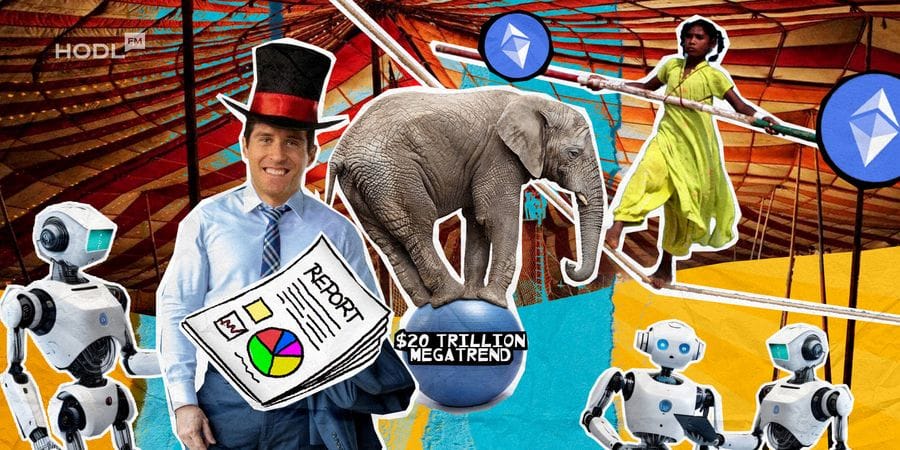Hi dear readers! In this digest edition, we dive into the latest developments that have rocked the crypto world. From a massive market crash which turned into a tragedy for tens of thousands of traders to ambitious mergers and the financially beneficial cooperation between AI and blockchain. Join us as we start our brief news overview.
Recent Crypto Crash Wipes Out Nearly $200 Million in Trader Positions
A staggering 83,912 traders were liquidated on June 11, with the total liquidation amounting to $190.97 million, according to crypto analytics firm CoinGlass. Bitcoin has fallen sharply, dropping 2.5% from a daily high of $69,547 to a low of $66,018. Ether fared even worse percentage-wise, falling 2.58% to $3,500.
Bitcoin traders bore the brunt of the losses, getting liquidated for $46.9 million, with $36.8 million coming from long positions and $14.07 million from short ones.
Ether traders didn’t have it much easier, registering the second-largest liquidation at $41.0 million, with $31.3 million from long positions and $9.68 million from short.

The market correction, followed by a bloodbath on leveraged markets, is linked to the upcoming Consumer Price Index (CPI) report for May and the Federal Open Market Committee (FOMC) meeting.
Historically, CPI data releases and FOMC rate changes have caused crypto market volatility, as investors scramble to shed risk.
When the CPI goes up, Bitcoin prices typically go down. The broader digital asset market isn’t spared either. As essential goods become pricier, people have less spare cash, which means fewer funds available for investing.
The Synergy of AI and Cryptocurrencies Could Boost Global GDP by $20 Trillion
PwC predicts that AI and cryptocurrencies could contribute $15.7 trillion and $1.8 trillion to the global economy by 2030, respectively. Although this totals $17.5 trillion, senior crypto research analyst Juan Leon believes that their synergy could have a compounding effect, potentially increasing the overall value to $20 trillion or more.
AI is creating an unprecedented shortage of data centers, AI chips, and electricity access. The world’s four largest cloud companies (Amazon, Google, Meta, Microsoft) are expected to spend nearly $200 billion on data center expansion in 2025 alone, mainly to meet the growing demand for AI.

New facilities are filling up quickly: about 83% of the capacity of data centers under construction has already been pre-leased, with AI companies and cloud providers driving this demand, according to a March report from commercial real estate firm CBRE Group. Data centers simply can’t keep up with the AI boom.
Enter Bitcoin miners, designed to process and store massive amounts of data. In other words, they have the very resources — powerful chips, advanced cooling systems, and associated infrastructure — that AI companies desperately need.
This demand is evidenced by CoreWeave’s offer last week to acquire Bitcoin miner Core Scientific (CORZ) for $1.6 billion, which is 55% above its market value. Core Scientific also announced the largest partnership to date between miners and AI, striking a $3.5 billion deal to host CoreWeave’s AI-related services.
Beyond Bitcoin mining, cryptocurrencies and AI have the potential to intersect in other areas, such as data verification and virtual assistants. These developments suggest that the integration of AI and cryptography will benefit both sectors, transforming how people innovate and interact with the world.
China’s Largest Bank Sees Huge Potential in Cryptocurrencies
Industrial and Commercial Bank of China (ICBC), the country’s largest bank, recently published a report highlighting the potential of cryptocurrencies. These include BTC, ETH, stablecoins, and central bank digital currencies (CBDCs). Notably, the report dubs Ethereum as “digital oil,” emphasizing its critical role in the digital economy.
While ICBC acknowledges that Bitcoin maintains a scarcity similar to gold, the bank also praises Ethereum for its continuous security, scalability, and sustainability updates. ICBC analysts argue that these attributes provide the technical prowess needed for a digital future.
The report is particularly notable given China’s strict stance on Bitcoin and crypto-related transactions. Traditional banks usually take a cautious approach to digital assets, making ICBC’s perspective even more significant.
However, ICBC points out that this flexibility comes with challenges. The bank highlights security issues arising from Ethereum’s Turing completeness, which allows for the execution of arbitrary code, including potentially malicious code. Additionally, complex smart contracts are vulnerable to exploits, complicating security audits.
The bank’s view aligns with a recent report from VanEck, which also refers to Ethereum as “digital oil.” They compare Ethereum to oil because it is consumed during the operation of the Ethereum network. Furthermore, they see Ethereum as “programmable money” due to its ability to automate financial transactions without intermediaries.
This endorsement from such a prominent financial institution underscores the growing importance of Ethereum and its potential for future technological advancements. So, while Bitcoin might be the digital gold, it looks like Ethereum is revving up to fuel the next wave of digital innovation.
Fetch.AI, SingularityNET, and Ocean Protocol’s Superintelligence Alliance Delay
The long-awaited merger of Fetch.AI (FET), SingularityNET (AGIX), and Ocean Protocol (OCEAN) into the Artificial Superintelligence Alliance (ASI) has been delayed until July 15, 2024. Following the announcement, the prices of FET, AGIX, and OCEAN dropped by 8.25%, 5.64%, and 4.06% respectively. Despite the temporary market impact, the delay is expected to benefit all stakeholders in the long run.

The delay is a strategic move to maintain high standards of accuracy and efficiency in the merger process. Humayun Sheikh, CEO of Fetch.ai and chairman of the Artificial Superintelligence Alliance, emphasized that the delay will not hinder the alliance’s progress toward creating a decentralized superintelligence network.
According to the alliance, the preparatory phase of the token merger involves managing complex integrations and coordinating with exchanges, validators, and other ecosystem participants. Ensuring the smooth operation of all these components requires meticulous planning and execution.
The alliance also confirmed that the token merger is on track, with no further delays expected. Once third-party integrations are complete, the ASI token will be launched. Eventually, the individual tokens will cease to trade separately and will merge into a single token. Token holders of FET, AGIX, and OCEAN can exchange their tokens for ASI at the following conversion rates:
– FET 1:1
– AGIX 1:0.433350
– OCEAN 1:0.433226.
While the merger has hit a slight speed bump, keep an eye on conversion rates and get ready to welcome the ASI token.
More:
- Digest 59: Gensler’s Fury, Gala Games’s Returns, Justice for SBF Team & NEAR’s AI Visions in Tech
- Digest 60: Stablecoins Bypassing Sanctions, Legal Bitcoin Wallet Hack, Grayscale’s Ether ETF Challenges, and AI Browsers Review
- Digest 61: TFTX Claim Spirals from $44B to $200M, XRP CEO “Seek Regulatory Clarity FIRST” DOG Just Went to the Moon, and Zoom’s New Digital Twin
Well, folks, this is it! The crypto world continues to be as unpredictable as ever, with dizzying crashes, ambitious mergers, and the intriguing intersection of AI and blockchain technologies. Stay tuned for next week’s edition as we once again dive into the world of relentless innovation and technological evolution.
Disclaimer: All materials on this site are for informational purposes only. None of the material should be interpreted as investment advice. Please note that despite the nature of much of the material created and hosted on this website, HODL FM is not a financial reference resource and the opinions of authors and other contributors are their own and should not be taken as financial advice. If you require advice of this sort, HODL FM strongly recommends contacting a qualified industry professional.




